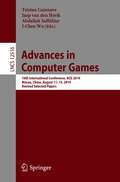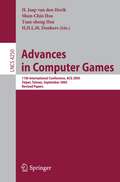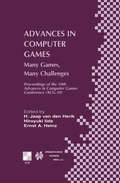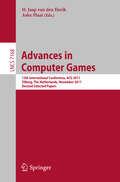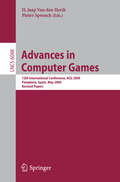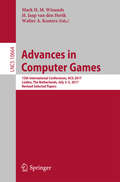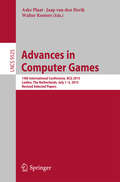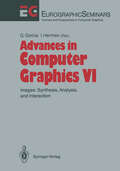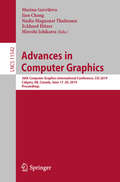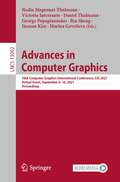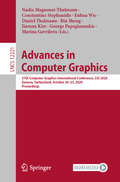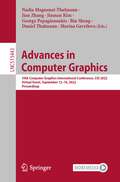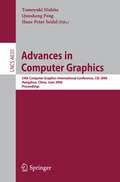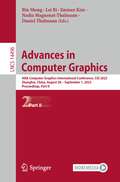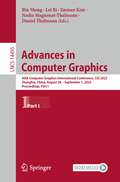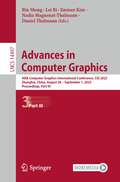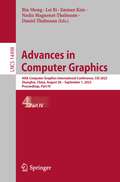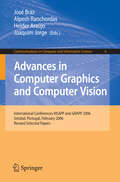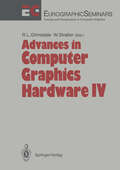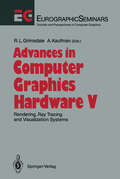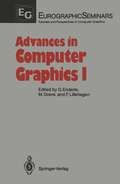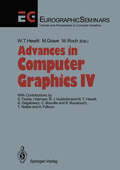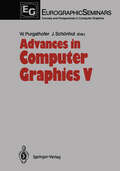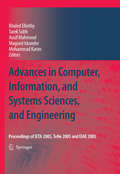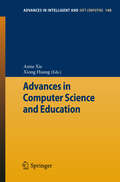- Table View
- List View
Advances in Computer Games: 16th International Conference, ACG 2019, Macao, China, August 11–13, 2019, Revised Selected Papers (Lecture Notes in Computer Science #12516)
by Tristan Cazenave Jaap van den Herik Abdallah Saffidine I-Chen WuThis book constitutes the refereed post-conference proceedings of the 16th International Conference on Advances in Computer Games, ACG 2019, held in Macao, China, in August 2019. The 12 full papers presented together with 2 invited papers were carefully reviewed and selected from 19 submissions. The selected papers are devoted to topics such as cooperation; single player games; mathematical approaches; nonogram: general and specific approaches; and deep learning.
Advances in Computer Games: 11th International Conference, ACG 2005, Taipei, Taiwan, September 6-8, 2005. Revised Papers (Lecture Notes in Computer Science #4250)
by H. Jaap Van Den Herik Shun-Chin Hsu Tsan-Sheng Hsu L. M. H. DonkersThis book constitutes the thoroughly refereed post-proceedings of the 11th International Conference on Advances in Computer Games, ACG 2005, held in Taipei, Taiwan, in September 2005 in conjunction with the 10th Computer Olympiad. It contains 20 papers that cover all aspects of artificial intelligence in computer-game playing.
Advances in Computer Games: Many Games, Many Challenges (IFIP Advances in Information and Communication Technology #135)
by H. Jaap Van Den Herik Hiroyuki Iida Ernst A. Heinz1 feel privileged that the J(jh Advances in Computer Games Conference (ACG 10) takes place in Graz, Styria, Austria. It is the frrst time that Austria acts as host country for this major event. The series of conferences started in Edinburgh, Scotland in 1975 and was then held four times in England, three times in The Netherlands, and once in Germany. The ACG-10 conference in Graz is special in that it is organised together with the 11th World Computer Chess Championship (WCCC), the Sth Computer Olympiad (CO), and the European Union Y outh Chess Championship. The 11 th WCCC and ACG 10 take place in the Dom im Berg (Dome in the Mountain), a high-tech space with multimedia equipment, located in the Schlossberg, in the centre of the city. The help of many sponsors (large and small) is gratefully acknowledged. They will make the organisation of this conference a success. In particular, 1 would like to thank the European Union for designating Graz as the Cultural Capital of Europe 2003. There are 24 accepted contributions by participants from all over the world: Europe, Japan, USA, and Canada. The specific research results ofthe ACG 10 are expected to tind their way to general applications. The results are described in the pages that follow. The international stature together with the technical importance of this conference reaffrrms the mandate of the International Computer Games Association (ICGA) to represent the computer-games community.
Advances in Computer Games: 13th International Conference, ACG 2011, Tilburg, The Netherlands, November 20-22, 2011, Revised Selected Papers (Lecture Notes in Computer Science #7168)
by H. Jaap Van Den Herik Aske PlaatThis book constitutes the thoroughly refereed post-conference proceedings of the 13th Advances in Computer Games Conference, ACG 2011, held in Tilburg, The Netherlands, in November 2011. The 29 revised full papers presented were carefully reviewed and selected from numerous submissions. The papers cover a wide range of topics such as Monte-Carlo tree search and its enhancement, temporal difference learning, optimization, solving and searching, analysis of a game characteristic, new approaches, and serious games.
Advances in Computer Games: 12th International Conference, ACG 2009, Pamplona, Spain, May 11-13, 2009, Revised Papers (Lecture Notes in Computer Science #6048)
by H. Jaap Van Den Herik Pieter SpronckAdvances in Computer Games: 15th International Conferences, ACG 2017, Leiden, The Netherlands, July 3–5, 2017, Revised Selected Papers (Lecture Notes in Computer Science #10664)
by Mark H.M. Winands H. Jaap van den Herik Walter A. KostersThis book constitutes the refereed conference proceedings of the 15th International Conference, ACG 2017, held in Leiden, The Netherlands, in July 2017.The 19 revised full papers were selected from 23 submissions and cover a wide range of computer games. They are grouped in four classes according to the order of publication: games and puzzles, go and chess, machine learning and MCTS, and gaming.
Advances in Computer Games: 14th International Conference, ACG 2015, Leiden, The Netherlands, July 1-3, 2015, Revised Selected Papers (Lecture Notes in Computer Science #9525)
by Aske Plaat Jaap van den Herik Walter KostersThis book constitutes the thoroughly refereed post-conference proceedings of the 14th International Conference on Advances in Computer Games, ACG 2015, held in Leiden, The Netherlands, in July 2015.The 22 revised full papers presented were carefully reviewed and selected from 34 submissions. The papers cover a wide range of topics such as Monte-Carlo Tree Search and its enhancements; theoretical aspects and complexity; analysis of game characteristics; search algorithms; and machine learning.
Advances in Computer Graphics: Images: Synthesis, Analysis, and Interaction (Focus on Computer Graphics)
by Gerald Garcia Ivan HermanThis book is a collection of several tutorials from the EUROGRAPHICS '90 conference in Montreux. The conference was held under the motto "IMAGES: Synthesis, Analysis and Interaction", and the tutorials, partly presented in this volume, reflect the conference theme. As such, this volume provides a unique collection of advanced texts on 'traditional' com puter graphics as well as of tutorials on image processing and image reconstruction. As with all the volumes of the series "Advances in Computer Graphics", the contributors are leading experts in their respective fields. The chapter Design and Display of Solid Models provides an extended introduction to interactive graphics techniques for design, fast display, and high-quality rendering of solid models. The text focuses on techniques for Constructive Solid Geometry (CSG). The follow ing topics are treated in depth: interactive design techniques (specification of curves, surfaces and solids; graphical user interfaces; procedural languages and direct manipulation) and display techniques (depth-buffer, scan-line and ray-tracing techniques; CSG classification techniques; efficiency-improving methods; software and hardware implementations).
Advances in Computer Graphics: 36th Computer Graphics International Conference, CGI 2019, Calgary, AB, Canada, June 17–20, 2019, Proceedings (Lecture Notes in Computer Science #11542)
by Marina Gavrilova Jian Chang Nadia Magnenat Thalmann Eckhard Hitzer Hiroshi IshikawaThis book constitutes the refereed proceedings of the 36th Computer Graphics International Conference, CGI 2019, held in Calgary, AB, Canada, in June 2019.The 30 revised full papers presented together with 28 short papers were carefully reviewed and selected from 231 submissions. The papers address topics such as: 3D reconstruction and rendering, virtual reality and augmented reality, computer animation, geometric modelling, geometric computing, shape and surface modelling, visual analytics, image processing, pattern recognition, motion planning, gait and activity biometric recognition, machine learning for graphics and applications in security, smart electronics, autonomous navigation systems, robotics, geographical information systems, and medicine and art.
Advances in Computer Graphics: 38th Computer Graphics International Conference, CGI 2021, Virtual Event, September 6–10, 2021, Proceedings (Lecture Notes in Computer Science #13002)
by Nadia Magnenat-Thalmann Victoria Interrante Daniel Thalmann George Papagiannakis Bin Sheng Jinman Kim Marina GavrilovaThis book constitutes the refereed proceedings of the 38th Computer Graphics International Conference, CGI 2021, held virtually in September 2021.The 44 full papers presented together with 9 short papers were carefully reviewed and selected from 131 submissions. The papers are organized in the following topics: computer animation; computer vision; geometric computing; human poses and gestures; image processing; medical imaging; physics-based simulation; rendering and textures; robotics and vision; visual analytics; VR/AR; and engage.
Advances in Computer Graphics: 37th Computer Graphics International Conference, CGI 2020, Geneva, Switzerland, October 20–23, 2020, Proceedings (Lecture Notes in Computer Science #12221)
by Nadia Magnenat-Thalmann Constantine Stephanidis Enhua Wu Daniel Thalmann Bin Sheng Jinman Kim George Papagiannakis Marina GavrilovaThis book constitutes the refereed proceedings of the 37th Computer Graphics International Conference, CGI 2020, held in Geneva, Switzerland, in October 2020. The conference was held virtually. The 43 full papers presented together with 3 short papers were carefully reviewed and selected from 189 submissions. The papers address topics such as: virtual reality; rendering and textures; augmented and mixed reality; video processing; image processing; fluid simulation and control; meshes and topology; visual simulation and aesthetics; human computer interaction; computer animation; geometric computing; robotics and vision; scientific visualization; and machine learning for graphics.
Advances in Computer Graphics: 39th Computer Graphics International Conference, CGI 2022, Virtual Event, September 12–16, 2022, Proceedings (Lecture Notes in Computer Science #13443)
by Nadia Magnenat-Thalmann Jian Zhang Jinman Kim George Papagiannakis Bin Sheng Daniel Thalmann Marina GavrilovaThis book constitutes the refereed proceedings of the 39th Computer Graphics International Conference on Advances in Computer Graphics, CGI 2022, held Virtually, during September 12–16, 2022. The 45 full papers included in this book were carefully reviewed and selected from 139 submissions. They were organized in topical sections as follows: image analysis & processing; graphs & networks; estimation & feature matching; 3d reconstruction; rendering & animation; detection & recognition; colors, paintings & layout; synthesis & generation; ar & user interfaces; medical imaging; segmentation; object detection; image attention & perception; and modeling & simulation.
Advances in Computer Graphics: 24th Computer Graphics International Conference, CGI 2006, Hangzhou, China, June 26-28, 2006, Proceedings (Lecture Notes in Computer Science #4035)
by Hans-Peter Seidel Tomoyuki Nishita Qunsheng PengThis is the refereed proceedings of the 24th Computer Graphics International Conference, CGI 2006. The 38 revised full papers and 37 revised short papers presented were carefully reviewed. The papers are organized in topical sections on rendering and texture, efficient modeling and deformation, digital geometry processing, shape matching and shape analysis, face, virtual reality, motion and image, as well as CAGD.
Advances in Computer Graphics: 40th Computer Graphics International Conference, CGI 2023, Shanghai, China, August 28–September 1, 2023, Proceedings, Part II (Lecture Notes in Computer Science #14496)
by Bin Sheng Lei Bi Jinman Kim Nadia Magnenat-Thalmann Daniel ThalmannThis 4-volume set of LNCS 14495-14498 constitutes the proceedings of the 40th Computer Graphics International Conference, CGI 2023, held in Shanghai, China, August 28 – September 1, 2023. The 149 papers in this set were carefully reviewed and selected from 385 submissions. They are organized in topical sections as follows: Detection and Recognition; Image Analysis and Processing; Image Restoration and Enhancement; Image Attention and Perception; Reconstruction; Rendering and Animation; Synthesis and Generation; Visual Analytics and Modeling; Graphics and AR/VR; Medical Imaging and Robotics; Theoretical Analysis; Image Analysis and Visualization in Advanced Medical Imaging Technology; Empowering Novel Geometric Algebra for Graphics and Engineering.
Advances in Computer Graphics: 40th Computer Graphics International Conference, CGI 2023, Shanghai, China, August 28 – September 1, 2023, Proceedings, Part I (Lecture Notes in Computer Science #14495)
by Bin Sheng Lei Bi Jinman Kim Nadia Magnenat-Thalmann Daniel ThalmannThis 4-volume set of LNCS 14495-14498 constitutes the proceedings of the 40th Computer Graphics International Conference, CGI 2023, held in Shanghai, China, August 28 – September 1, 2023. The 149 papers in this set were carefully reviewed and selected from 385 submissions. They are organized in topical sections as follows: Detection and Recognition; Image Analysis and Processing; Image Restoration and Enhancement; Image Attention and Perception; Reconstruction; Rendering and Animation; Synthesis and Generation; Visual Analytics and Modeling; Graphics and AR/VR; Medical Imaging and Robotics; Theoretical Analysis; Image Analysis and Visualization in Advanced Medical Imaging Technology; Empowering Novel Geometric Algebra for Graphics and Engineering.
Advances in Computer Graphics: 40th Computer Graphics International Conference, CGI 2023, Shanghai, China, August 28 – September 1, 2023, Proceedings, Part III (Lecture Notes in Computer Science #14497)
by Bin Sheng Lei Bi Jinman Kim Nadia Magnenat-Thalmann Daniel ThalmannThis 4-volume set of LNCS 14495-14498 constitutes the proceedings of the 40th Computer Graphics International Conference, CGI 2023, held in Shanghai, China, August 28 – September 1, 2023. The 149 papers in this set were carefully reviewed and selected from 385 submissions. They are organized in topical sections as follows: Detection and Recognition; Image Analysis and Processing; Image Restoration and Enhancement; Image Attention and Perception; Reconstruction; Rendering and Animation; Synthesis and Generation; Visual Analytics and Modeling; Graphics and AR/VR; Medical Imaging and Robotics; Theoretical Analysis; Image Analysis and Visualization in Advanced Medical Imaging Technology; Empowering Novel Geometric Algebra for Graphics and Engineering.
Advances in Computer Graphics: 40th Computer Graphics International Conference, CGI 2023, Shanghai, China, August 28 – September 1, 2023, Proceedings, Part IV (Lecture Notes in Computer Science #14498)
by Bin Sheng Lei Bi Jinman Kim Nadia Magnenat-Thalmann Daniel ThalmannThis 4-volume set of LNCS 14495-14498 constitutes the proceedings of the 40th Computer Graphics International Conference, CGI 2023, held in Shanghai, China, August 28 – September 1, 2023. The 149 papers in this set were carefully reviewed and selected from 385 submissions. They are organized in topical sections as follows: Detection and Recognition; Image Analysis and Processing; Image Restoration and Enhancement; Image Attention and Perception; Reconstruction; Rendering and Animation; Synthesis and Generation; Visual Analytics and Modeling; Graphics and AR/VR; Medical Imaging and Robotics; Theoretical Analysis; Image Analysis and Visualization in Advanced Medical Imaging Technology; Empowering Novel Geometric Algebra for Graphics and Engineering.
Advances in Computer Graphics and Computer Vision: International Conferences VISAPP and GRAPP 2006, Setúbal, Portugal, February 25-28, 2006, Revised Selected Papers (Communications in Computer and Information Science #4)
by Helder Araújo Joaquim Jorge José Braz Alpesh RanchordasThis book includes selected papers of the VISAPP and GRAPP International Conferences 2006, held in Funchal, Madeira, Portugal, February 25-28, 2006. The 27 revised full papers presented were carefully reviewed and selected from 314 submissions. The topics include geometry and modeling, rendering, animation and simulation, interactive environments, image formation and processing, image analysis, image understanding, motion, tracking and stereo vision.
Advances in Computer Graphics Hardware IV (Focus on Computer Graphics)
by Richard L. Grimsdale Wolfgang StraßerEUROGRAPHICS workshops on Graphics hardware have now become an established forum for an exchange of information con cerning the latest developments in this field of growing importance. The first workshop took place during EG'86 in Lisbon. All parti cipants in this event considered it a very rewarding workshop to be repeated at future EG conferences. This view was reinforced at the EG'87 Hardware Workshop in Amsterdam which firmly esta blished the need for and a high interest in such a colloquium of technical discussion in this specialist area within the annual EG conference. The third EG Hardware Workshop took place in Nice in 1988 and this volume is a record of the fourth workshop at EG'89 in Hamburg. The material in this book contains papers representing a com prehensive record of the contributions to the 1989 workshop. The first part considers Algorithms and Architectures of graphics systems. These papers discuss the broader issues of system design, without necessarily raising issues concerning the details of the implementation. The second part on Systems describes hardware solutions and realisations of machines dedicated to graphics processing. Many of these contributions make important references to algorithmic and architectural issues as well, but there is now a greater emphasis on realisation. Indeed many VLSI designs are described.
Advances in Computer Graphics Hardware V: Rendering, Ray Tracing and Visualization Systems (Focus on Computer Graphics)
by Richard L. Grimsdale Arie KaufmanThis volume contains papers representing a comprehensive record of the contributions to the fifth workshop at EG '90 in Lausanne. The Eurographics hardware workshops have now become an established forum for the exchange of information about the latest developments in this field of growing importance. The first workshop took place during EG '86 in Lisbon. All participants considered this to be a very rewarding event to be repeated at future EG conferences. This view was reinforced at the EG '87 Hardware Workshop in Amsterdam and firmly established the need for such a colloquium in this specialist area within the annual EG conference. The third EG Hardware Workshop took place in Nice in 1988 and the fourth in Hamburg at EG '89. The first part of the book is devoted to rendering machines. The papers in this part address techniques for accelerating the rendering of images and efficient ways of improv ing their quality. The second part on ray tracing describes algorithms and architectures for producing photorealistic images, with emphasis on ways of reducing the time for this computationally intensive task. The third part on visualization systems covers a num ber of topics, including voxel-based systems, radiosity, animation and special rendering techniques. The contributions show that there is flourishing activity in the development of new algorithmic and architectural ideas and, in particular, in absorbing the impact of VLSI technology. The increasing diversity of applications encourage new solutions, and graphics hardware has become a research area of high activity and importance.
Advances in Computer Graphics I (Focus on Computer Graphics)
by Günter Enderle Michel Grave Frank LillehagenThis book is the sixth issue in the EurographicSeminars Series. This series has been set up by Eurographics, the European Association for Computer Graphics, in order to disseminate surveys and research results out of the field of Computer Graphics. Computer Graphics constitute a powerful and versatile tool for various application areas. The rapidly increasing use of Computer Graphics techniques and systems in many areas is caused by the availability of more powerful hardware at lower prices,' by the concise specification of Computer Graphics Interfaces in commonly·.agreed standards, and by the inven tion of new and often astonishing methods and algorithms for com position andpreserit~ti6n of pictJres and for graphical interaction. While s,o~e issues of this se.ries contain latest research results, e.g. the issues in window management systems or user interface manage ment systems, this book has the character of a state-of-the-art survey on important areas .of Computer Graphics. Starting from current practice and agreed consens, it will lead to the latest achievements in this field. The contributions in this issue are largely based on tutorials and seminars held at the Eurographics conferences 1984 in Copen hagen and 1985 in Nice.
Advances in Computer Graphics IV (Focus on Computer Graphics)
by E. Fiume I. Herman R. J. Hubbold W. T. Hewitt A. Gagalowicz C. Bouville K. Bouatouch T. Nadas A. FellousThis fourth volume of Advances in Computer Graphics gathers together a selection of the tutorials presented at the EUROGRAPHICS annual conference in Nice, France, Septem ber 1988. The six contributions cover various disciplines in Computer Graphics, giving either an in-depth view of a specific topic or an updated overview of a large area. Chapter 1, Object-oriented Computer Graphics, introduces the concepts of object ori ented programming and shows how they can be applied in different fields of Computer Graphics, such as modelling, animation and user interface design. Finally, it provides an extensive bibliography for those who want to know more about this fast growing subject. Chapter 2, Projective Geometry and Computer Graphics, is a detailed presentation of the mathematics of projective geometry, which serves as the mathematical background for all graphic packages, including GKS, GKS-3D and PRIGS. This useful paper gives in a single document information formerly scattered throughout the literature and can be used as a reference for those who have to implement graphics and CAD systems. Chapter 3, GKS-3D and PHIGS: Theory and Practice, describes both standards for 3D graphics, and shows how each of them is better adapted in different typical applications. It provides answers to those who have to choose a basic 3D graphics library for their developments, or to people who have to define their future policy for graphics.
Advances in Computer Graphics V (Focus on Computer Graphics)
by Werner Purgathofer Jürgen SchönhutThis book collects together several of the tutorials held at EUROGRAPHICS'89 in Hamburg. The conference was held under the motto "Integration, Visualisation, Interaction" and the tutorials reflect the conference theme. The Springer series EurographicSeminars with the volumes "Advances in Computer Graphics" regularly provides a professional update on current mainstream topics in the field. These publications give readers the opportunity to inform themselves thoroughly on the topics covered. The success of the series is mainly based on the expertise of the contributing authors, who are recognized professionals in their field. Starting out with one of the conference's main topics, the chapter "Visualization of Scientific Data" gives an overview of methods for displaying scientific results in an easily surveyable and comprehensible form. It presents algorithms and methods utilized to achieve visualization results in a form adequate for humans. User interfaces for such systems are also explored, and practical conclusions are drawn. The chapter "Color in Computer Graphics" describes the problems of manipulating and matching color in the real world. After some fundamental statements about color models and their relationships, the main emphasis is placed on the problem of objective color specification for computer graphics systems. It is very hard to match colors between devices such as scanners, printers and displays. Some suggestions on the effective use of color for graphics are also made.
Advances in Computer, Information, and Systems Sciences, and Engineering: Proceedings of IETA 2005, TeNe 2005 and EIAE 2005
by Mohammad A. Karim Khaled Elleithy Tarek Sobh Ausif Mahmood Magued IskanderThe conference proceedings of: International Conference on Industrial Electronics, Technology & Automation (IETA 05) International Conference on Telecommunications and Networking (TeNe 05) International Conference on Engineering Education, Instructional Technology, Assessment, and E-learning (EIAE 05) include a set of rigorously reviewed world-class manuscripts addressing and detailing state-of-the-art research projects in the areas of: Industrial Electronics, Technology and Automation, Telecommunications, Networking, Engineering Education, Instructional Technology and e-Learning. The three conferences, (IETA 05, TENE 05 and EIAE 05) were part of the International Joint Conference on Computer, Information, and System Sciences, and Engineering (CISSE 2005). CISSE 2005, the World's first Engineering/Computing and Systems Research E-Conference was the first high-caliber Research Conference in the world to be completely conducted online in real-time via the internet. CISSE received 255 research paper submissions and the final program included 140 accepted papers, from more than 45 countries. The whole concept and format of CISSE 2005 was very exciting and ground-breaking. The powerpoint presentations, final paper manuscripts and time schedule for live presentations over the web had been available for 3 weeks prior to the start of the conference for all registrants, so they could pick and choose the presentations they want to attend and think about questions that they might want to ask. The live audio presentations were also recorded and are part of the permanent CISSE archive, which includes all power point presentations, papers and recorded presentations. All aspects of the conference were managed on-line; not only the reviewing, submissions and registration processes; but also the actual conference. Conference participants - authors, presenters and attendees - only needed an internet connection and sound available on their computers in order to be able to contribute and participate in this international ground-breaking conference. The on-line structure of this high-quality event allowed academic professionals and industry participants to contribute work and attend world-class technical presentations based on rigorously refereed submissions, live, without the need for investing significant travel funds or time out of the office. Suffice to say that CISSE received submissions from more than 50 countries, for whose researchers, this opportunity presented a much more affordable, dynamic and well-planned event to attend and submit their work to, versus a classic, on-the-ground conference. The CISSE conference audio room provided superb audio even over low speed internet connections, the ability to display PowerPoint presentations, and cross-platform compatibility (the conferencing software runs on Windows, Mac, and any other operating system that supports Java). In addition, the conferencing system allowed for an unlimited number of participants, which in turn granted CISSE the opportunity to allow all participants to attend all presentations, as opposed to limiting the number of available seats for each session. The implemented conferencing technology, starting with the submission & review system and ending with the online conferencing capability, allowed CISSE to conduct a very high quality, fulfilling event for all participants. See: www.cissee2005.org, sections: IETA, TENE, EIAE
Advances in Computer Science and Education (Advances in Intelligent and Soft Computing #140)
by Anne Xie Xiong HuangCSE2011 is an integrated conference concentration its focus on computer science and education. In the proceeding, you can learn much more knowledge about computer science and education of researchers from all around the world. The main role of the proceeding is to be used as an exchange pillar for researchers who are working in the mentioned fields. In order to meet the high quality of Springer, AISC series, the organization committee has made their efforts to do the following things. Firstly, poor quality paper has been refused after reviewing course by anonymous referee experts. Secondly, periodically review meetings have been held around the reviewers about five times for exchanging reviewing suggestions. Finally, the conference organizers had several preliminary sessions before the conference. Through efforts of different people and departments, the conference will be successful and fruitful.
